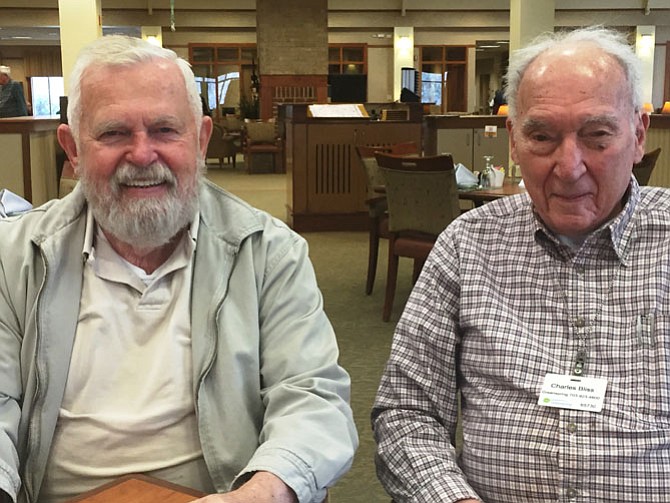Charlie Bliss (right) and Charley Moseley received their first U.S. patent together as co-inventors in late 2015. Photo contributed
Data recently released from NASA and NOAA confirmed that 2015 marked the hottest year since record keeping began in the late 1800s. Their data also confirms that 2015 was not an outlier; in fact, 15 of the 16 hottest years in history have been recorded since the turn of the century. In response to the data, NASA Administrator Charles Bolden indicated that “climate change is the challenge of our generation.” Greenspring retirement community resident, 98-year-old Charlie Bliss, and his 78-year-old colleague Charley Moseley, are doing their part to suggest options for combating global warming; the two recently received a U.S. Patent (US 9,187,724), citing a method for utilizing captured carbon dioxide through the cultivation of microalgae, thus reducing harmful emissions to the atmosphere. Bliss will be honored for his achievements at Greenspring during the community’s annual Earth Day celebration this April.
Bliss and Moseley first met while working for the United States Agency for International Development (USAID) in Pakistan in 1981. Moseley was the head of USAID/Pakistan’s Office of Energy and Environment, and Bliss was an officer in the central Office of Energy where his focus was on the USAID technical and economic assistance program to Pakistan. During this time, he with Moseley participated in a comprehensive feasibility study aimed at establishing the first modern coal mining and power generation installation in the country, while also meeting their international standards for environmental protection. In recent years, Bliss has served as an independent consultant focusing on his concern over the declining role of coal-based power generation in the United States. These activities led to the application for a U.S. Patent, for which he and Moseley are co-inventors.
Bliss and Moseley cite the Environmental Protection Agency’s (EPA) current plan to slow global warming tends toward closing power plants and eliminating the use of coal. They suggest a more constructive approach; cleaning up the burning of coal by finding uses for carbon dioxide other than storing it underground before it has the opportunity to enter the atmosphere. NOAA confirms that when the concentration of carbon dioxide in the atmosphere goes up, its temperature also goes up. While permanently storing carbon dioxide underground is a known option, Bliss and Moseley suggest that a better option is to produce a cost-effective way to capture the carbon dioxide and to find uses that yield revenue.
In their recently awarded patent, Bliss and Moseley have specified a method for cultivating and processing microalgae, which includes directing a continuous supply of carbon dioxide into an enclosed container, known as a photobioreactor, containing microalgae. Photosynthesis chemical reactions using renewable solar energy take place in the photobioreactor, producing both an algae biomass and a gaseous mixture. A separation occurs of the two substances, which can then be used in a variety of ways, such as for cattle feed and creating a renewable diesel fuel. Their patent industrializes the photosynthesis reaction and according to Bliss and Moseley, produces revenue rather than cost. The next step for them involves a physical demonstration that this is a viable process and a valuable substitution for current methodology. They have also just filed for a second patent complimenting the first.
Charles Bliss has spent his career as a progressive chemical engineer specializing in energy and economic development. He was awarded the professional degree of Chemical Engineer in 1948 by The Cooper Union in New York; 63 years later in 2011, his alma mater recognized his achievements with the Gano Dunn award for outstanding achievement in engineering, industry, or finance. This most recent patent marks Bliss’ fifth U.S. Patent, but his first since the 1950s. Bliss first moved to the D.C. area from Boston in 1976; 13 years ago, he moved to Greenspring in Springfield. At age 98, Bliss suggests that his longevity may be due to the enduring ability to do what he loves. “I like retirement so much, I do it often,” said Bliss.
